A Thing of Beauty… _|_ Issue 16, 2020
A Thing of Beauty… The Book of Kells
James Harpur ‘takes a line for a walk’ as he remembers the challenges of writing his poem ‘Kells’
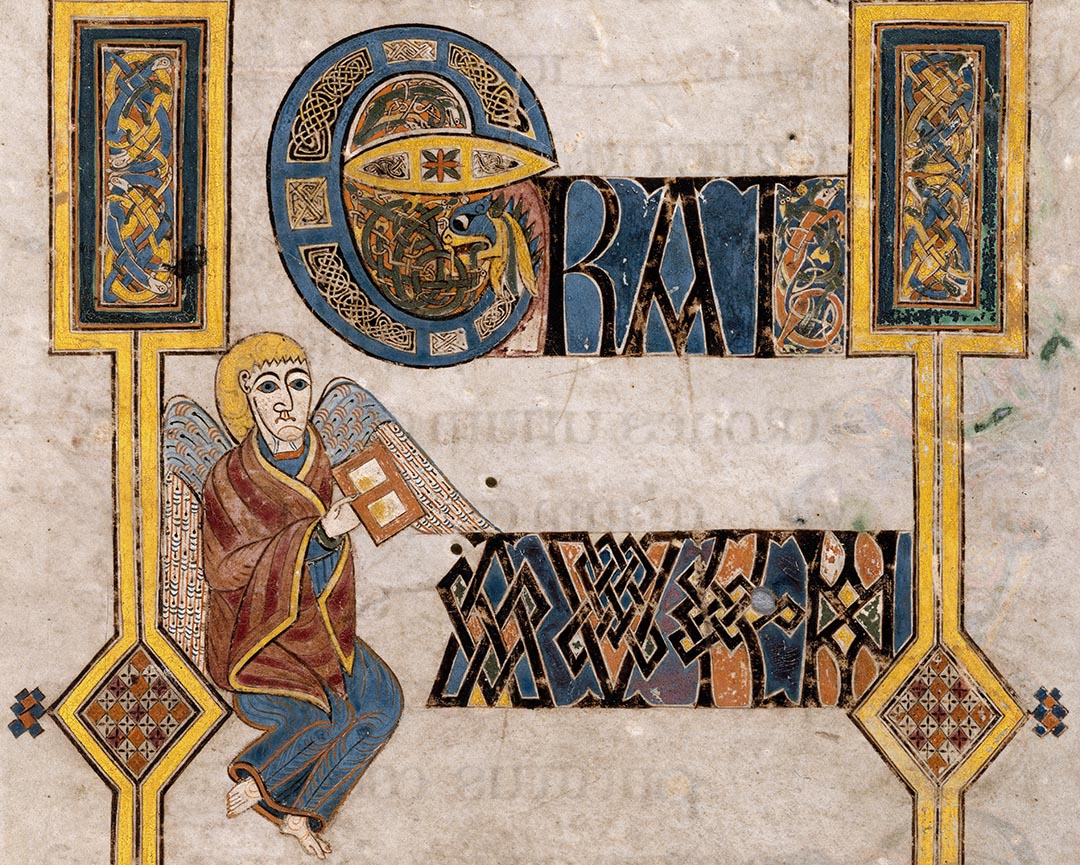
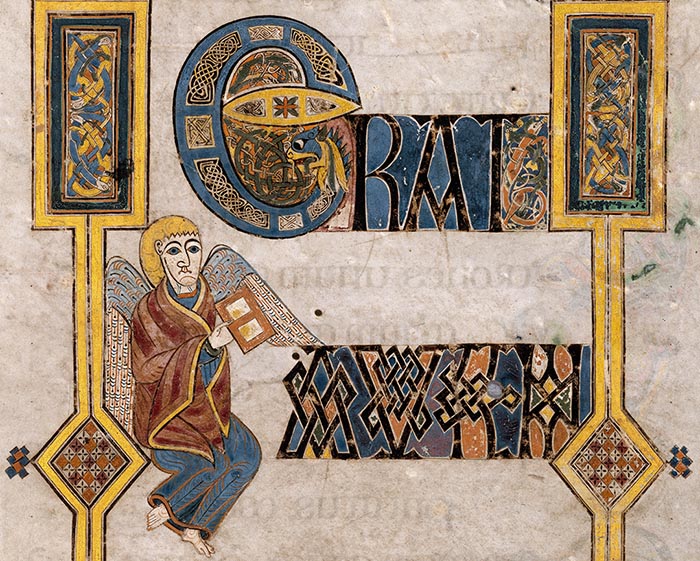
A Thing of Beauty… The Book of Kells
James Harpur ‘takes a line for a walk’ as he remembers the challenges of writing his poem ‘Kells’
In this latest addition to our series ‘A Thing of Beauty…’, the poet James Harpur describes how he has been inspired by the great Irish masterpiece of illumination, the Book of Kells, and gives an account of his own artistic struggle to write a poem in its honour. The result, ‘Kells’, was published in The White Silhouette,[1] which in 2018 was an Irish Times Book of the Year.
If you want to explore the Book of Kells in more detail – as it is impossible to capture its wondrous intricacy in a few images – Trinity College Dublin have put the complete work online in high resolution; click here [/]
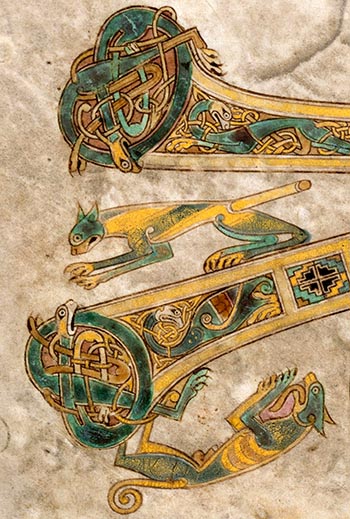 The Book of Kells, named after the medieval monastery of Kells in County Meath in the Republic of Ireland, is a decorated copy of the four gospel accounts. Thought to have been created in the late 8th or early 9th century, the book is a masterpiece of sacred art with its full-page illuminations, its spirals and interlace patterns and depictions of angels, people and animals. It is now on display in Trinity College Library, Dublin.
The Book of Kells, named after the medieval monastery of Kells in County Meath in the Republic of Ireland, is a decorated copy of the four gospel accounts. Thought to have been created in the late 8th or early 9th century, the book is a masterpiece of sacred art with its full-page illuminations, its spirals and interlace patterns and depictions of angels, people and animals. It is now on display in Trinity College Library, Dublin.
I am not the first writer to be enthralled and bamboozled by the Book of Kells (or ‘Kook of Bells’, as Samuel Beckett once referred to it). It has inspired and delighted writers through the ages, possibly as far back as the 12th century, when the Anglo-Norman churchman and chronicler Gerald of Wales (Giraldus Cambrensis) may have seen it in the monastery of Kildare. James Joyce said it was ‘the most purely Irish thing we have’ and that you could compare the book’s dense illuminations to the verbal intricacies of his own work – not least in Finnegan’s Wake, in which he refers to ‘the tenebrous Tunc page of the Book of Kells’.[2]
My own first proper awareness of the work occurred back in the mid-1980s when I was editing an illustrated book about the Bible. One of the chosen illustrations was Kells’ Chi Rho page – a ‘carpet’ illumination dominated by the Greek letters for ‘Ch’ and ‘R’, which begin the word Christi at the start of Matthew 1.18: ‘Christi autem generatio sic erat’ (This is how the birth of Jesus Christ came about …). When I first saw this page I knew how Keats’s ‘stout Cortez’ felt when he first saw the Pacific Ocean.[3] The illumination was like watching a match being dropped into a box of fireworks and freezing the result. The letter Chi itself – which resembles a curvy capital X – looked as if it was breaking cover and springing naked from a foliage of geometry, its arms curved, its right leg extended, its left leg kicked up behind – running to incarnate itself. Such kinetic energy within the stillness of a picture!
From then on the Book of Kells, and in particular Chi Rho, was lodged in my psyche, biding its time – for I had a strong feeling that one day I would write a poem about it. As it turned out, the decisive trigger came many years later in 1999, when I received a commission from the UK Poetry Society to write a long poem about ‘a place’. I don’t know why, but I asked speculatively if a book counted as ‘a place’, and they said it did: the moment was ripe to write about Kells.
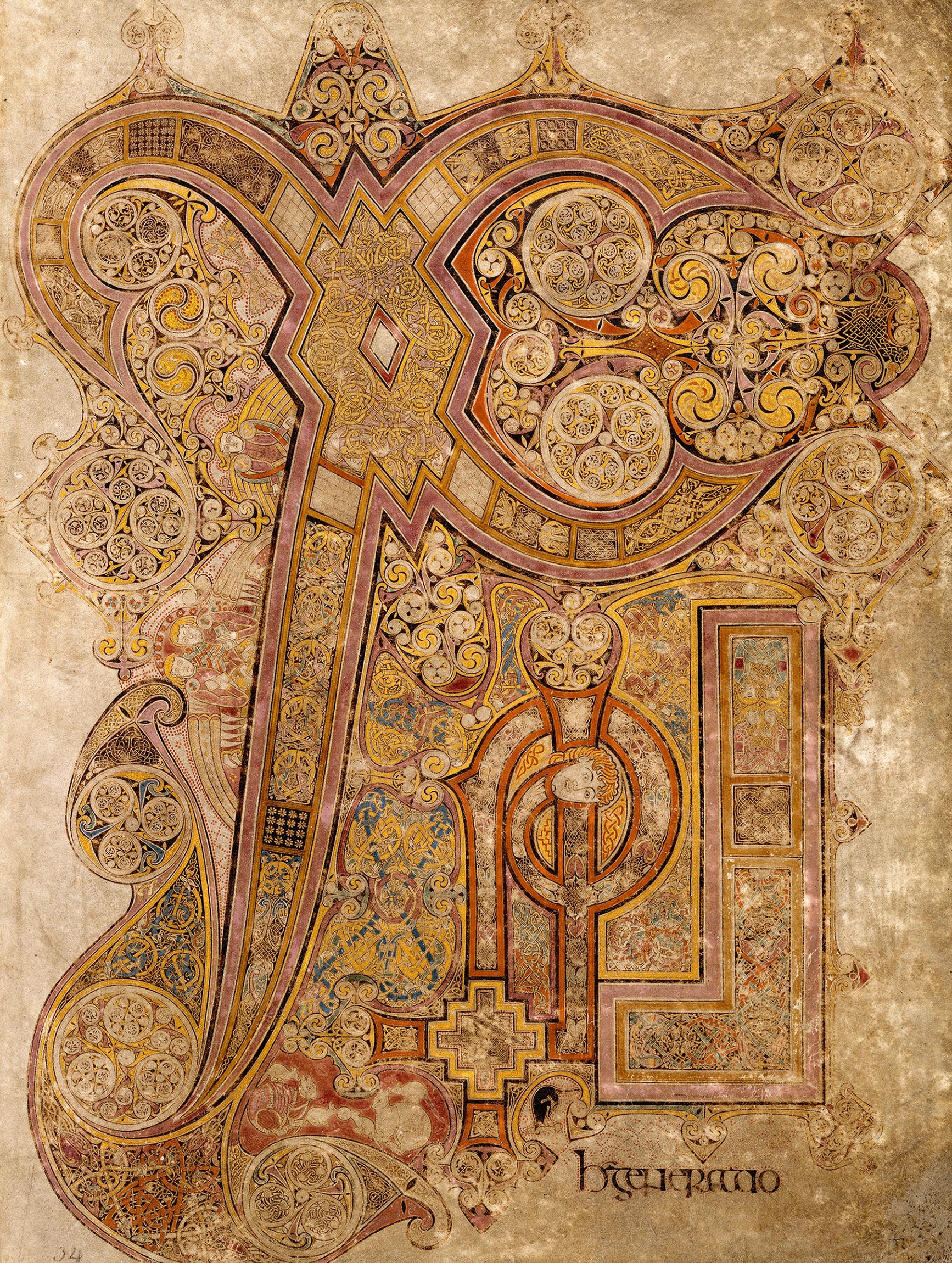
Run your mouse over the picture to zoom in on the details.
The Chi Rho page, folio 34r of The Book of Kells, Gospel of Matthew on the conception. The text reads: Christi autem generatio (Christ was born). Image: courtesy of The Board of Trinity College Dublin
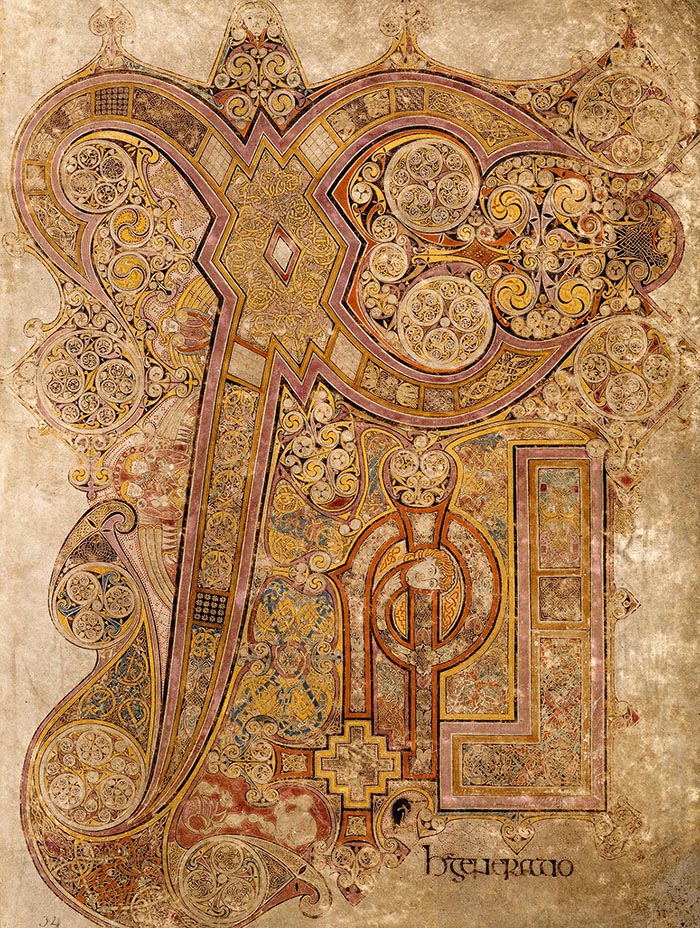
The Chi Rho page, Folio 34r of The Book of Kells, Gospel of Matthew on the conception. The text reads: Christi autem generatio (Christ was born). Image: courtesy of The Board of Trinity College Dublin
The Blank Page
.
From the outset I had virtually no idea of how I was going to approach the poem. I sensed that Kells somehow held a key to great spiritual or aesthetic truths, but I was not sure how to explore its richness. I felt like Mr Casaubon in Middlemarch, poring over material to construct his magnum opus, The Key to All Mythologies, a work he never manages to complete.[4] I had committed myself to the subject matter; I had been paid a commission: the only thing missing was inspiration.
You cannot manufacture poetic inspiration – it is something that comes to you unbidden. But you can try to leave the window open by meditating, daydreaming or entering what Ted Hughes called the ‘sacred trance’, a sort of self-induced liminal state of consciousness that has the quality of daydream, but with an extra element of intention or awareness about it – not dissimilar to Jung’s ‘active imagination’. Despite my attempts to enter this state, however, ideas continued to evade me. Indeed, I suspected that my very desire to write and get to the heart of Kells was probably blocking any flow of creativity. More than once I fantasised about abandoning the project and giving back my commission, or at least changing the ‘place’ I’d chosen.
Eventually, during a period of meditative silence, with a blank page on my desk, an idea arrived. It was literally staring me in the face in all its blank nothingness: what would it be like for one of the Kells’ illuminators to suffer from creative block? Why would not an artist working more than a thousand years ago experience the same issues of creativity as a contemporary one? By having this thought I immediately formed an emotional connection with the illuminator of Chi Rho. He had his commission, I had mine. At some point he – whoever he was – had to stare at his blank vellum, just as I was staring at my paper. What would he have felt? Responsibility? Excitement? Hopelessness? How did the visual ideas come to him?
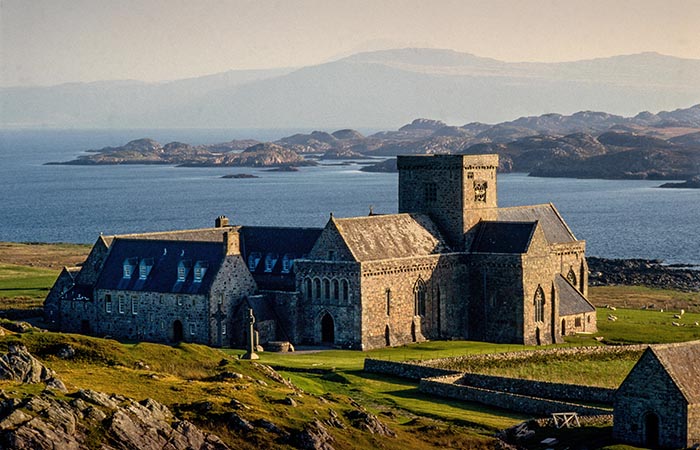
The island of Iona where Goldsmith might have produced his illuminated pages for The Book of Kells. Image: Brian Harris/Alamy Stock Photo
Goldsmith
.
For an intense period I read about Kells and gazed at the illuminations. I found out that the French scholar Françoise Henry proposed there were three major Kells artists, whom she nicknamed the ‘goldsmith’, the ‘portrait painter’ and the ‘illustrator’.[5] Her terminology conjured up not individual personalities but archetypes, as if Kells was the product or reproduction of a divine template. Goldsmith she nicknamed because of his love of orpiment, a yellowish mineral that was used as a substitute for gold leaf. It was he, she believed, who was the creator of the Chi Rho page. My imagination began to make sinuous Kells-like connections with this illuminator. The first thing was situating him in a time and place, and I had to look no further than Iona, the island off the West coast of Scotland where many scholars believe Kells was begun in about 800CE.
This was my starting point: Goldsmith. Chi Rho. Iona, about 800. I could feel my poetic antennae reaching out towards this individual, trying to make psychic contact with him. What was he like? What brought him to Iona? How did he feel before he went about creating arguably one of the most dynamic images in Western art – indeed, in any art? What pressure was he under to create such an illumination? How did he relate his art to his faith? Did he start with a detail in his mind then expand it, or did he have an overview based on other images he had seen? How much did he improvise?
My questions about him were also questions about myself and my own poetic practice. The relationship between faith and art, for example; the question of aesthetics in relation to sacred objects. Can art lead to the divine, or does it in fact lead away from the divine? On the one hand there is the sacro-aesthetic view embodied in the words that Abbot Suger (c.1081–1151) had inscribed over the door of the abbey church of Saint-Denis in Paris: Mens hebes ad verum per materialia surgit (The dull mind rises to the truth through material things). On the other hand there is the view symbolised by the Cistercian statute (c.1145) that states: Vitreae albae fiant, et sine crucibus et picturis (Let the windows be made of white glass without images or crosses [6]). These two different approaches seem to me to represent, respectively, the classic via affirmativa and via negativa of the Christian mystics, and I have an affinity with both paths.
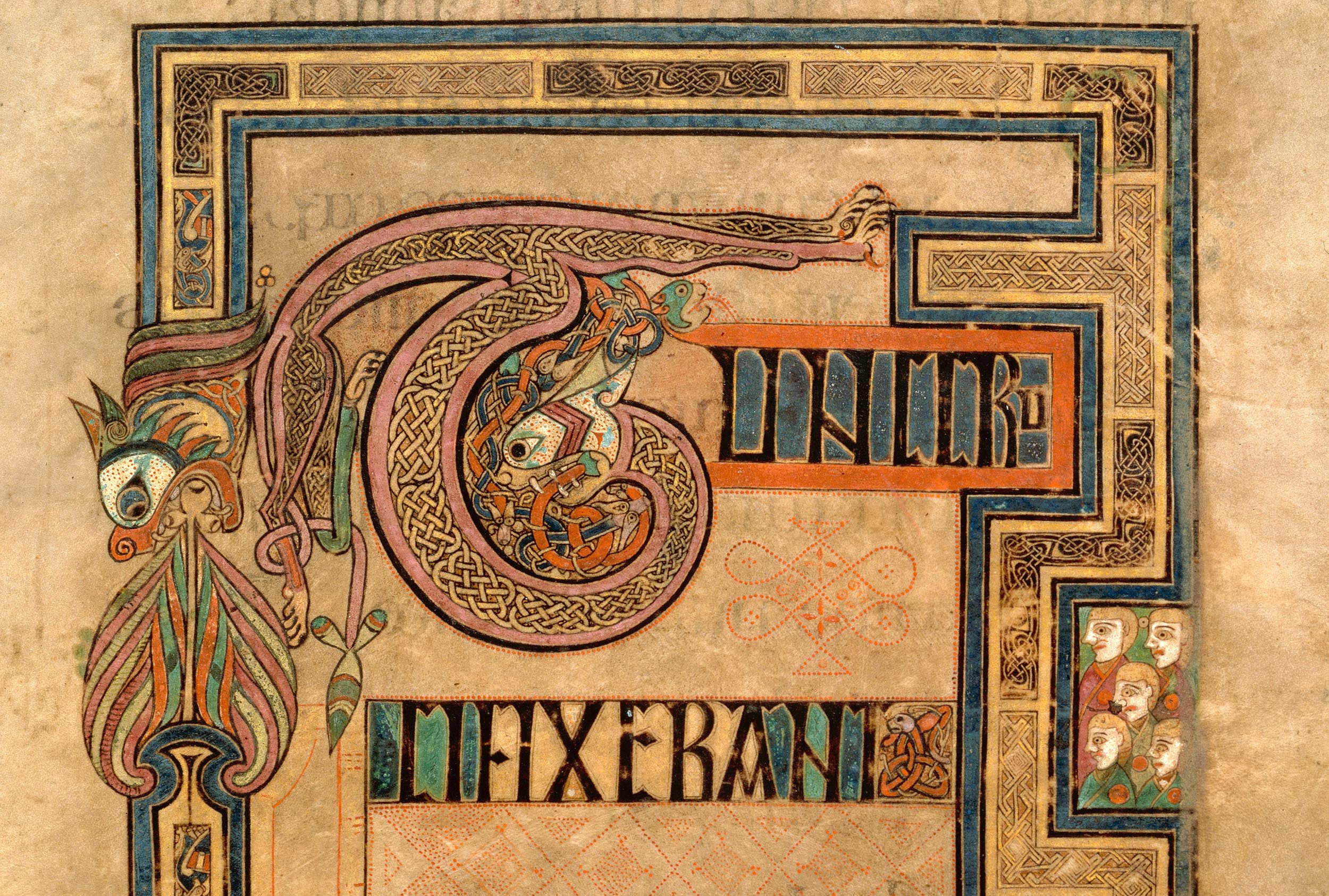
Run your mouse over the picture to zoom in on the details.
The ‘tenebrous Tunc page’, folio 124r of The Book of Kells, Gospel of Matthew on the crucifixion. The text of the full page reads: Tunc crucifixerant xpi cum eo du/os latrones (Then were crucified with him two thieves). Image: courtesy of The Board of Trinity College Dublin
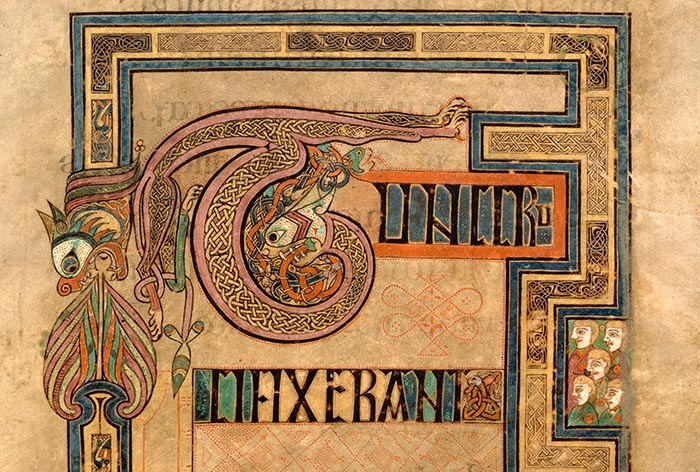
The ‘tenebrous’ Tunc page, Folio 124r of The Book of Kells, Gospel of Matthew on the crucifixion. The text reads: ‘Tunc crucifixerant xpi cum eo du/os latrones’ (Then were crucified with him two thieves). Image: courtesy of The Board of Trinity College Dublin
Even with a location (Iona) and a protagonist (Goldsmith), I was still struggling to find a way into the poem. My staring at Chi Rho and waiting for a thread to emerge became counterproductive, for with its swirls of detail and Escher-like circularities of lines, the page is almost designed to stop your eye from resting on it: the mind is lured into a maze of circuits and cul-de-sacs. My staring and reflecting were producing nothing. Then, once again, just as a sense of futility was setting in, I had another breakthrough: ‘nothing’ would be a theme – that is, the struggle with finding the first spark of the creative act, of making something ex nihilo. That seemed promising but nothing comes from nothing – you cannot write about not writing without putting pen to paper.
Then I was reminded of Paul Klee’s words on starting a work of art: ‘I begin where all pictorial form begins: with a point that sets itself in motion.’ It is fine advice for a writer too: in literary terms, Klee’s artistic point would be a single word or an isolated idea or image. Begin small and let it expand. Klee also expressed the idea that drawing was a matter of the artist ‘taking a line for a walk’ – something Goldsmith did with extraordinary effect. Could I take a word or a line of poetry for a walk? And, if I did, would it result in something coherent or chaotic? In staring at Goldsmith’s Chi Rho intricacies I was also reminded of the words of the modern Belgian–French poet Henri Michaux, reacting to Klee’s paintings:
The complex network of lines appeared little by little: lines living with the little people of dust and dots, crossing crumbs, going around cells, fields of cells, or turning, turning in spirals to fascinate—or to find what had fascinated—umbelliferous plants and agates. Lines walking around … labyrinth of the eternal return. A line meets a line. A line avoids a line. Adventures of lines.[7]
Michaux could have been describing Chi Rho. Could I create my own adventure of lines?
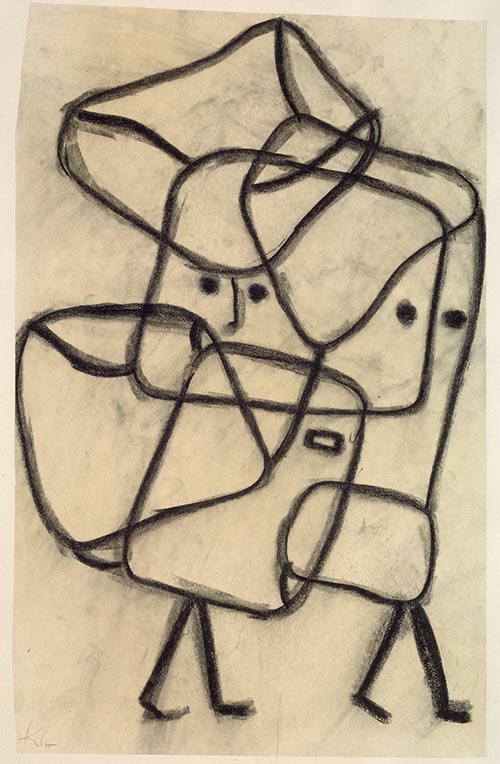
Burdened Children by Paul Klee (1930). The drawing consists of an almost unbroken line, demonstrating the movement from a point to a line, which in turn creates planar forms. For more, click here [/]. Image: courtesy The Tate Gallery
First Words
.
With Klee and Michaux on my shoulders, I decided to let myself surrender to a single image, thought or word. And what kept swimming into consciousness was the word (and image) ‘Iona’. It felt solid and reassuring, an island in a sea of flux. I had visited in the early 1990s and was surprised by how small it was, and also how its alleged ‘atmosphere of miracle’ – the division between the material and spiritual being ‘paper thin’ – seemed palpably true. At night with just the sound of the sea and the patchy appearance of stars, I could have been in St Columba’s era back in the sixth century, an impression maintained in the daytime when I explored the island’s unspoiled fields and its tucked-away coves. It was relatively easy to dematerialise the late medieval and modern buildings and imagine Columba and his companions huddled in their wooden huts, or filing into their oaken church within a protective circular bank and ditch; or indeed, grazing their cattle, or sowing seed on the west of the island, or hunting for seals.
So there I was, contemplating a blank white page, trying to focus on the island of Iona and feeling that my alter ego, Goldsmith, was also staring at a blank page. Then like footprints found in overnight snow, I saw the first stumbling words appear on the page. They went like this:
I walk along the path that leads
past rocky outcrops, nascent brambles;
waves of oceanic wind
slice through the frozen twilit sheep.
I knew the words were not right – that they were a five-finger exercise. But they had broken the ice. They had at least established a movement, a person – Goldsmith / myself – walking along a path on Iona, and also a season – the frozen sheep made me think of early March.
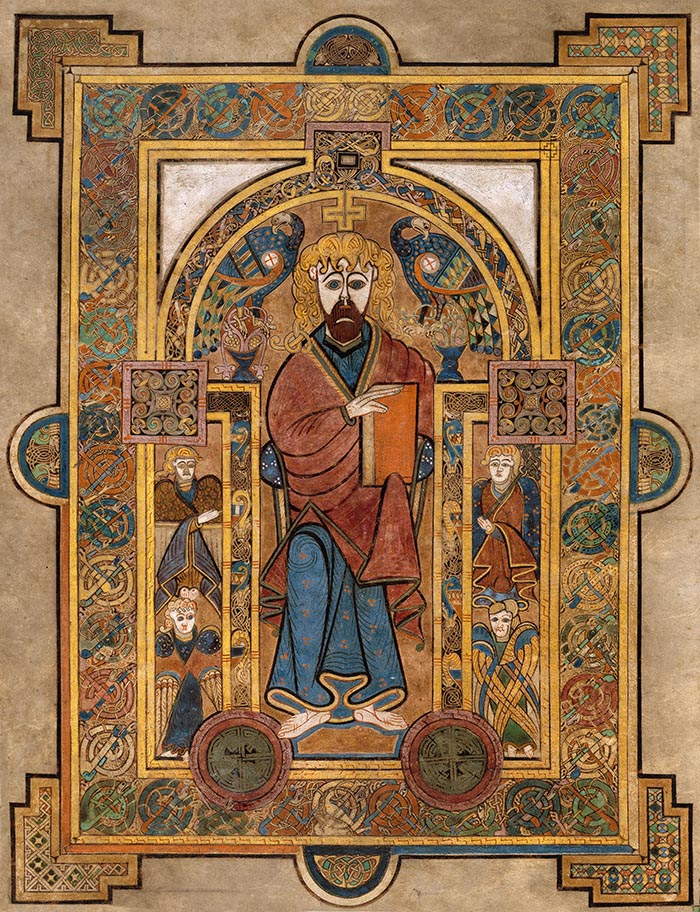
Run your mouse over the picture to zoom in on the details.
Portrait of Christ, folio 32v of The Book of Kells, Gospel of Matthew. Image: courtesy of The Board of Trinity College Dublin

Portrait of Christ. Folio 32v of The Book of Kells, Gospel of Matthew. Image: courtesy of The Board of Trinity College Dublin
Mandala
.
Most productively, the lines had arrived with a four-stress rhythm, tending towards iambic tetrameter, and this, in turn, gave me the idea that the number four was going to be key to the poem. I thought of the nature of the four-pronged letter Chi, dominating its page; and then the four evangelists and their four versions of the gospel; and of course the cross. The Chi Rho page also reminded me of Jung’s thesis that the number four is a symbol of ‘wholeness’, as well as his suggestion that mandala images in Tibetan Buddhism, with their square frames enclosing a circle or circles, resemble some of the dream images of his patients. They are, he believed, the visual manifestation of the psyche trying to restore order and balance to chaos and disorientation. In other words, mandalas are instruments of healing:
In the products of the unconscious we discover mandala symbols, that is, circular and quaternary figures which express wholeness, and whenever we wish to express wholeness, we employ just such figures.[8]
In the Kells’ illuminations, time after time, a fourfold frame encloses a fuse box of kinetic images: circles whirling like Hindu swastikas, tendrils of plants creeping everywhere, angels floating in the air, vermin scrapping on the ground, and the haunting faces of apostles, saints and churchmen, sometimes solitary, sometimes crushed together. The frame keeps the energy in check, for the most part; sometimes the frame is broken, or its edges do not quite meet, or there are quirky elements of asymmetry. From a Jungian perspective, the illuminations seem to embody the chaos of conscious thought and emotion, yet at the same time instil a sense of harmony, of healing.
The idea of four as the basic pulse of a line of verse hypnotised me. It also led me to a breakthrough concerning the poem itself. I had chosen Goldsmith as my protagonist, but the questions I wanted him to pose, and the tension I wanted him to bear, were too many and too much already for one character to carry. What would happen if I had four characters and four places? This would indicate a poem that had four parts, each part with its own frame, and all four parts framed by the unity of a single book. A new burst of energy came along with new questions. Who would the other characters be? What other places? How would they reflect different aspects of Kells as well as my own inner life?
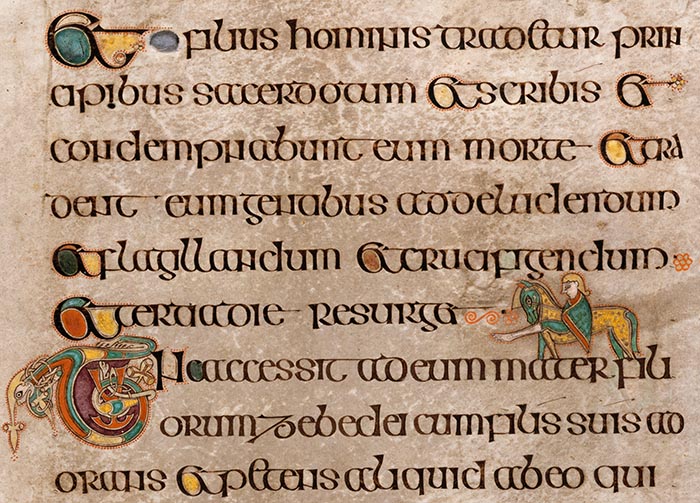
Details from folio 89 of The Book of Kells, Gospel of Matthew. Image: courtesy of The Board of Trinity College Dublin
The Four Characters
.
It seemed to me I needed a scribe as another character. A writer. Someone confronted by a set of aesthetic and existential problems different to those experienced by my illuminator. A writer who was a copyist not a creator. A scribe located at the monastery of Kells itself in the midlands of Ireland, who had perhaps migrated there with others from Iona after a murderous Viking raid (such as the one that actually happened in 806) and had worked on the completion of the book. A scribe tasked to reproduce sacred words but with, perhaps, a mind full of self-doubt, anxieties and even memories of the Viking trauma. The idea grew in its appeal. So then I had two creators of Kells – Goldsmith and Scribe – and two locations, Iona and Kells.
To complete the foursome, and to complement the two creators, I decided I wanted two characters who were witnesses of the book. After all, Kells was designed to be looked at as much as read. When the book was ritually held up and displayed in chapel, the intention was to make viewers marvel at it and thereby see the world and themselves in a different light – sub specie aeternitatis to be precise. A work of art can only come to its final completion when it is witnessed.
Sometimes when I look up at the night sky and see the stars receding into galaxies I have to look away because the scale and awfulness of creation is too much. I feel the same, to some extent, with Kells. And this is what Gerald of Wales, author of The History and Topography of Ireland, felt when he first saw an illuminated gospel book (thought by some scholars to be Kells) in the abbey of Kildare in about 1185.[9] How, he asked himself, could a human being possibly create such a marvel?
The explanation he seemed satisfied with was told to him by one of the Kildare monks: the book’s creator received a vision from an angel holding up a divine template of what the book should look like. All the monk had to do was pray and copy the vision. The story suggests that inspiration is a matter of copying the archetype, not creating an ‘original’ and personal work of art. I found this idea fascinating – so different from the world view underlying modern art – and I decided to choose Gerald as my third protagonist and Kildare as the place.
Lastly, I wanted a witness in the modern world, a writer perhaps, visiting Trinity College in the 1990s and seeing the Book in its current existence in a glass incubator – like a patient in intensive care. I temporarily called this modern writer ‘Scribbler’.
So there was my initial scheme, configured on the number four: Goldsmith and Iona; Scribe and Kells; Gerald of Wales and Kildare; and Scribbler and Dublin. With this provisional plan, I began writing the first draft of Goldsmith, and as I did so I was led into trails of small epiphanies and cul-de-sacs. My character began to take on life and I watched in fascination as he began to exhale visible breath in the icy interior of his Ionan cell.
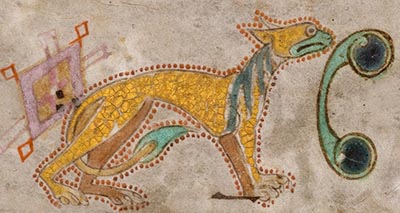
Extract from ‘Goldsmith’ (from ‘Kells’)
.
I watch him watch the vellum
inflict its infinite paralysis.
I think: ‘Christ’ is not a ‘person’,
but energia, lux fluens,
the ceaseless flow of light that moves
il sole e l’altre stella
and seeds the sort of love
that blossoms when self has lost itself.
I think: Christ cannot be painted,
but only his effect on nature –
creation that’s been Christed.
I want to tell the monk: Surrender!
Then what’s beyond the cave
of your tiny sheltered self
will swarm in – like bees to clover –
and spin like Ezekiel’s wheels –
your work will be an arc – for lions,
eagles, snakes, and angels,
who move invisible among us –
I say nothing. His hand is still.
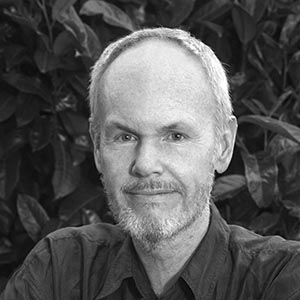
James Harpur is a poet living in West Cork. He has published six collections of poetry, including Angels and Harvesters (2012) and The Dark Age (2007), with Anvil Press and Carcanet, and is a member of Aosdána, the Irish academy of the arts. He has won a number of awards, including the UK National Poetry Competition. For more about his work, see www.jamesharpur.com [/]
Image Sources (click to close)
Banner: Folio 183r from the Book of Kells, the Gospel of Mark on the crucifixion. The text reads Erat autem hora tercia (It was the third hour). Image: courtesy of The Board of Trinity College Dublin.
First inset: Detail from folio 19v of the Book of Kells. Image: courtesy of The Board of Trinity College Dublin.
Final Image: Detail from folio 89r of The Book of Kells, Gospel of Matthew. Image: courtesy of The Board of Trinity College Dublin.
Other Sources (click to open)
[1] JAMES HARPUR, The White Silhouette (Carcanet, 2018).
[2] JAMES JOYCE, Finnegan’s Wake (The Viking Press, 1939), p.122.
[3] JOHN KEATS, On First Looking at Chapman’s Homer, published 1816.
[4] Cited in BERNARD MEEHAN, The Book of Kells (Thames and Hudson, 1994), p.78.
[5] GEORGE ELLIOT, Middlemarch: A Study of Provincial Life, published 1871–2.
[6] HENRI MICHAUX, Darkness Moves: An Henri Michaux Anthology, 1927–1984, trans. and ed. David Ball (Berkeley, University of California Press, 1997), pp.316–7.
[7] RICHARD MARKS, Stained Glass in England During the Middle Ages (Routledge, 1993), p.111.
[8] CARL JUNG, Memories, Dreams, Reflections (London, Fontana, 1995), Chapter XI, ‘Life after Death’.
[9] Gerald of Wales, The History and Topography of Ireland, trans. John O’Mears (Penguin Books, 1982), Book 2, Chapters 71 and 72.
Email this page to a friend
FOLLOW AND LIKE US
——————————————
——————————————
——————————————
FOLLOW AND LIKE US
If you enjoyed reading this article
Please leave a comment below.
Please also consider making a donation to support the work of Beshara Magazine. The magazine relies entirely on voluntary support. Donations received through this website go towards editorial expenses, eg. image rights, travel expenses, and website maintenance and development costs.
READ MORE IN BESHARA MAGAZINE
A Thing of Beauty…
Mark Boston reflects on painting the film Loving Vincent
A Thing of Beauty…
Emma Clark visits the Luohan at the Temple Gallery in London
Mary, Seat of Wisdom and Mercy
Jane Carol contemplates the depiction of the Virgin Mary at Chartres Cathedral
Calligraphy – A Sacred Tradition
Distinguished calligrapher Ann Hechle talks about her lifelong quest to understand the underlying unity of the world
READERS’ COMMENTS

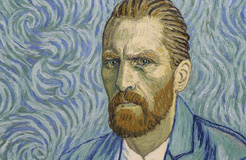

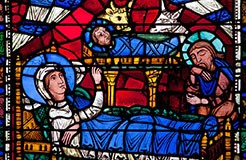
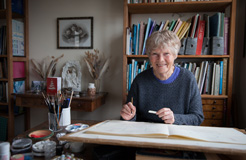
“Beauty will save the world” Dostoyevsky
Yes beauty shall save our souls and nature spirits
Absolutely beautiful article. I found myself seeing the Book of Kells as though for the first time.
Jules
1